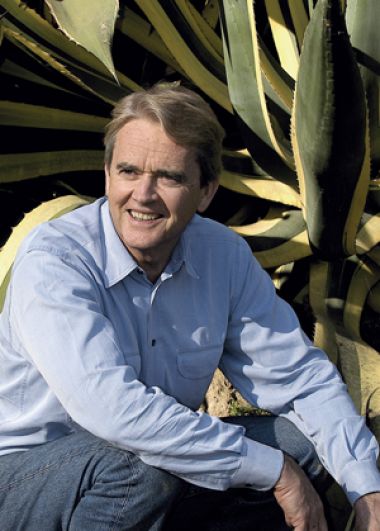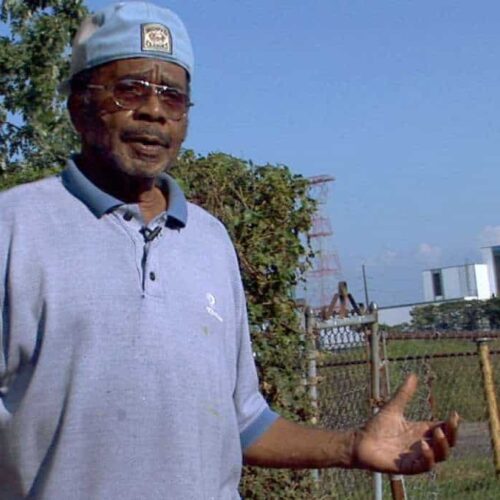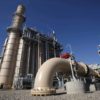Introduction
The stumbling, two-decade-old war on hazardous air pollutants — declared on Nov. 15, 1990, the day President George H. W. Bush signed the Clean Air Act amendments into law — has stalled on bureaucratic dawdling, industry resistance, legal maneuvering, limited resources and politics. Untainted air for all Americans — promised by Bush — has proved elusive.
As the Center for Public Integrity’s iWatch News and NPR have reported, the pollutants persist in hundreds of communities, the result of regulators’ failure to act on a mandate from Washington and the best consensus from scientists. Internal records show that Clean Air Act violations sometimes languish for years without sufficient scrutiny or enforcement.
Ridding the nation’s air of nearly 200 dangerous chemicals has proved anything but easy. “It’s a little bit of a hit-or-miss approach,” said William K. Reilly, who led the U.S. Environmental Protection Agency during the first Bush administration and is now a senior advisor to TPG Capital LP, an international private equity fund. “It sometimes seems like it’s ‘toxic of the moment.’ And it takes a considerable amount of time to effect the removal of a toxic once it’s identified as a target.”
Just writing the rules has been a drawn-out process, with much of the work unfinished even before the EPA ran into partisan headwinds as Republicans began targeting regulation in general and the EPA in particular in the run-up to the 2012 presidential election. Legislation passed by the GOP-controlled House of Representatives this fall would leave many communities vulnerable to airborne chemicals, among them the Philadelphia suburb of Chester, Pa., which has more than a dozen polluters within or near its boundaries.
Elwood Patrick moved to Chester in 1968 — 24 years before a large, foul-smelling waste-to-energy plant was built within a quarter-mile of his house, adding to the already substantial pollution burden created by oil refineries, a pulp mill and other industries in the area. The air in his neighborhood has gotten worse, said Patrick, who is 81. “You can’t keep nothing clean. Sometimes you need a mask on your face. They told me a long time ago that I should move and I wish I had. But now I’m an old man and I can’t go nowhere.”

Places like Chester are hit with chemical brews that may be more dangerous than their mixtures’ individual components.
“We’ve not really, I think, scratched the surface … in dealing with the effects of toxics as they combine and exacerbate each other,” said former Bush EPA chief Reilly.
‘Grossly delinquent’ EPA
From the start, the bureaucratic machine sputtered. The EPA fell behind on issuing air toxics rules for swaths of industries such as chemical manufacturers, paint-stripping operations and tire makers. And even when the rules did come out, they were often branded as weak by environmentalists, who went to court in search of relief. Judges disparaged a number of the rules, scolding EPA officials and tossing their work back to the agency for revision.
The law anticipated speedier results. Rather than requiring standards for individual chemicals, a tortuous process that, it was feared, would lead to lengthy delays, Congress instructed the EPA to draw up rules covering groups of industries such as oil refineries, power plants and steel mills. Companies would have to use the best available pollution controls, which would catch most of the poisons before they could escape into the atmosphere. Ceaseless arguments over the toxicity of compounds like styrene and acetaldehyde would be averted.
On paper, the plan looked terrific. But air toxics took a back seat to so-called “criteria pollutants” — more ubiquitous compounds such as sulfur dioxide, a contributor to smog. The brown-yellow haze blighted major metropolitan areas, and many Americans wanted it gone. Pollutants such as air toxics, though dangerous, were localized and not always so obvious.
“The air toxics are not as visible as … the early air pollution. I remember coming to Washington and seeing brown smog almost every day; it was all associated with the automobile,” said William Ruckelshaus, the EPA’s first administrator, under Richard Nixon, and its fifth, under Ronald Reagan. “I don’t think there’s as much understanding on the part of the public of the nature of these toxic problems and the potential threat to public health. Because if there were — if it were like it was back in the ‘70s — there would be demand for action to do something about these things.” [Read a Q&A with Ruckelshaus on the bipartisan failure to curb air toxics here.]
A federal judge underlined the EPA’s failures on air toxics in a 2006 opinion. “Congress directed EPA in 1990 to begin executing these tasks on a specific schedule set by statute,” he wrote. “EPA has been grossly delinquent in making serious efforts to comply. And far from making the required showing that it has exercised its ‘utmost diligence’ in its efforts to comply with statutory deadlines … [the agency] has not even attempted to justify its delinquency up to this point.”
A prime example of the EPA’s tardiness: its halting attempts to limit the amount of brain-damaging mercury that spews from coal-fired power plants. Its 2005 mercury rule was struck down by a judge three years later. Under a court-imposed deadline, the EPA came back last March with a rule it said would prevent “91 percent of mercury in coal from being released into the air.”
The rule wouldn’t take effect until 2015, however, and its final form is still being decided. The EPA has received hundreds of thousands of public comments, many of them from industry officials arguing that the health benefits of mercury reductions — fewer children with attention-deficit disorder and lowered IQs, to name a couple — would be minuscule compared with the costs of retrofitting old power plants with pollution controls.
EPA’s ‘hopelessly irrational’ methods
The EPA has issued 96 air toxics rules to date, ordering industries such as boat manufacturing, gold mine ore processing and iron and steel foundries to hold down emissions using “maximum achievable control technology.”
But these rules can still allow significant amounts of chemicals to escape. “They provide far less protection than the Clean Air Act requires,” said James Pew, a staff attorney with Earthjustice, a nonprofit public-interest law firm. “People in many communities are exposed to unacceptable levels of pollutants that can cause cancer, birth defects and other serious health effects.”
Earthjustice has sued the EPA over air toxics rules perhaps a dozen times in the past 15 years. Ten of those cases made their way to a final decision in the U.S. Court of Appeals for the D.C. Circuit, and Earthjustice prevailed in nine of them. In all nine, judges held that the rules being challenged were unlawful or arbitrary and sent them back to the EPA for reworking.
In one case, involving medical waste incinerators, a three-judge panel wrote, “EPA’s method looks hopelessly irrational.” In another, involving brick kilns, the court opined tartly that “If the Environmental Protection Agency disagrees with the Clean Air Act’s requirements for setting emissions standards, it should take its concerns to Congress.”
“The same defects that led the court to send these rules back infects many, if not all, of the other air toxics rules EPA issued,” Pew said. “The Clean Air Act is actually a very clear law. One administration after another has just refused to implement it because they didn’t want to offend the powerful industry interests that didn’t want to have to control their pollution.”
In addition to the mercury rule for power plants, the Obama EPA has issued or is about to issue rules governing toxic emissions from industrial boilers, incinerators and cement kilns. “These are the last categories that we have,” Gina McCarthy, the agency’s assistant administrator for air and climate, told iWatch News and NPR. “I admit they are difficult and they have always been contentious, but this administration is committed to doing what the Clean Air Act says. We’re in the public health protection business, and these rules enhance public health tremendously. They save lives every year.”
But the rules are under attack by the affected industries and their allies in Congress, mostly Republicans emboldened by the president’s surprise decision in September to pull back a planned EPA standard on ozone, the main ingredient in smog, ostensibly to shield the fragile economy from further damage.
In October, the GOP-led House voted to delay the cement-kiln rule, which, according to House Majority Leader Eric Cantor, R-Va., “would add tremendous new costs to cement plants, sap capital that could be invested in expanding and hiring, and could force some employers to close their facilities.” The chamber has since passed bills delaying rules on power plants, cement kilns, incinerators and boilers.
Former EPA Administrator Ruckelshaus, a strategic director at the Madrona Venture Group, a private equity fund, takes exception to the “job-killer” label some of his fellow Republicans have attached to the agency.
“Almost whatever EPA does, there’s going to be an objection to it on the basis that it costs too much and it’s going to cost jobs,” he said. “I tend to discount an awful lot of that. But when you have a public receptive to those kinds of arguments, the industry is going to make them just so they don’t have to make the kinds of expenditures that they feel will render them less competitive. … If they keep fighting [regulation] all the time, eventually the public will turn on them — particularly if the economic situation improves.”
A peer-reviewed, congressionally mandated EPA study released in March concluded that the benefits of the 1990 law will far outweigh the costs. The costs of compliance will reach $65 billion per year by 2020, the study estimates. But the benefits of fewer pollution-related deaths and illnesses — mostly associated with exposure to ozone and fine particles — will approach $2 trillion annually by that time, the study predicts.
Nonetheless, legislation aimed at delaying rules on boilers, incinerators and cement kilns is pending in the Senate. And the power plant rule has become a rallying point for those who believe the EPA is overreaching. At a House committee hearing on Nov. 1, Virginia’s Republican attorney general, Ken Cuccinelli, said there is “no dispute that the [maximum achievable control technology] rule will increase electricity prices [and] no question that, nationwide, it will close some businesses and further strain families that are just surviving at the margin.”
Bryan Hannegan, vice president for environment and renewables at the Electric Power Research Institute, a nonprofit research-and-development firm, said in an interview that pollution controls can be expensive and troublesome to install. “It’s not as simple as just adding another widget on the back end of the plant,” he said. “These are very complex, very large engineering projects.”
Uncertainty about the nature and timing of the air toxics rule clouds decision-making on investments that can run into tens or hundreds of millions of dollars, Hannegan said. “Ultimately,” he said, “what these power companies are interested in is creating power. But they also have to turn a profit for their shareholders.”
Emma Schwartz contributed to this story.
Read more in Environment
Environment
Limits on mercury and soot could save billions, improve public health, studies say
Proposed new emissions regulations are under attack from GOP and industry





Join the conversation
Show Comments